On test: Stacks of power in diddy JCB 530-60
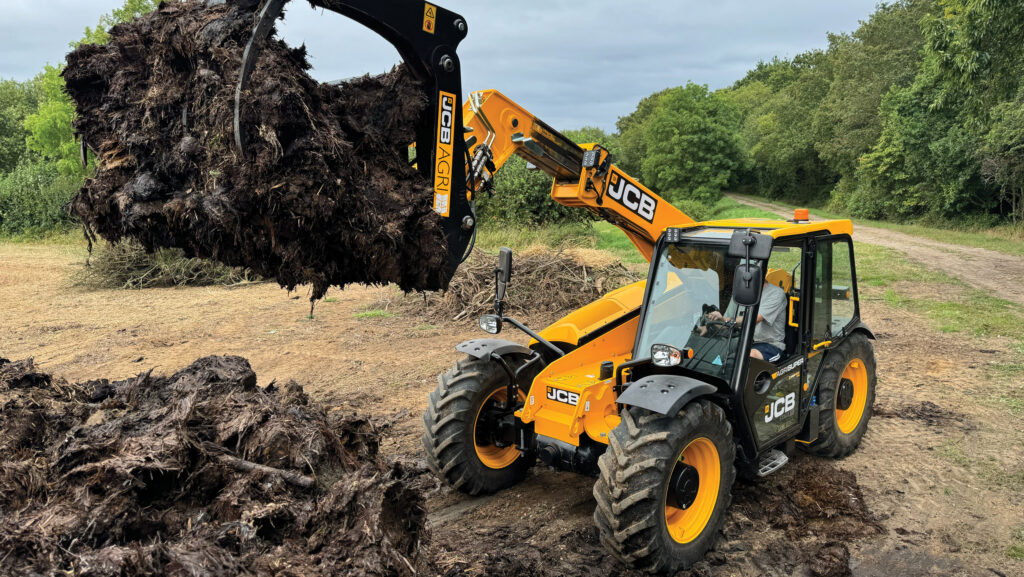 © MAG/Oliver Mark
© MAG/Oliver Mark JCB’s engineers have successfully completed telehandler themed Tetris by cramming almost all the components from the largest Loadalls into a package condensed in all dimensions.
That makes the diminutive 530-60 superior to its predecessor, the 527-58, in almost every regard, with improvements in power, torque, lift capacity and reach.
But one crucial stat has remained unchanged – height.
See also: Revamped JCBs in demand as prices for new machinery rise
Even on the bigger 24in wheels it measures just 2.14m tall (shrinking to a smidge over 2m on 20-inchers) and 2.12m wide, so it’s ideal for slinking under the awkwardly low roofs and between the barriers of many a pig and poultry farm.
But those pint-sized proportions needn’t limit its wider appeal, with a healthy 3t lift and 6m of vertical reach – plus an ample 130hp to boot – making it a potentially versatile machine for anyone not concerned with stacking bales to the heavens.
Squished
Sunflower-yellow paint aside, its squat appearance is reminiscent of a small Merlo, with the low-slung cockpit plonking the operator between, rather than above, front and rear axles.
This dwarfish format has required some rearrangement of key components, with the engine dropped deeper into the chassis.
The AdBlue after-treatment system is somehow shoehorned into a cramped engine bay, and the diesel filling spout now protruding from the gulley beneath the boom.
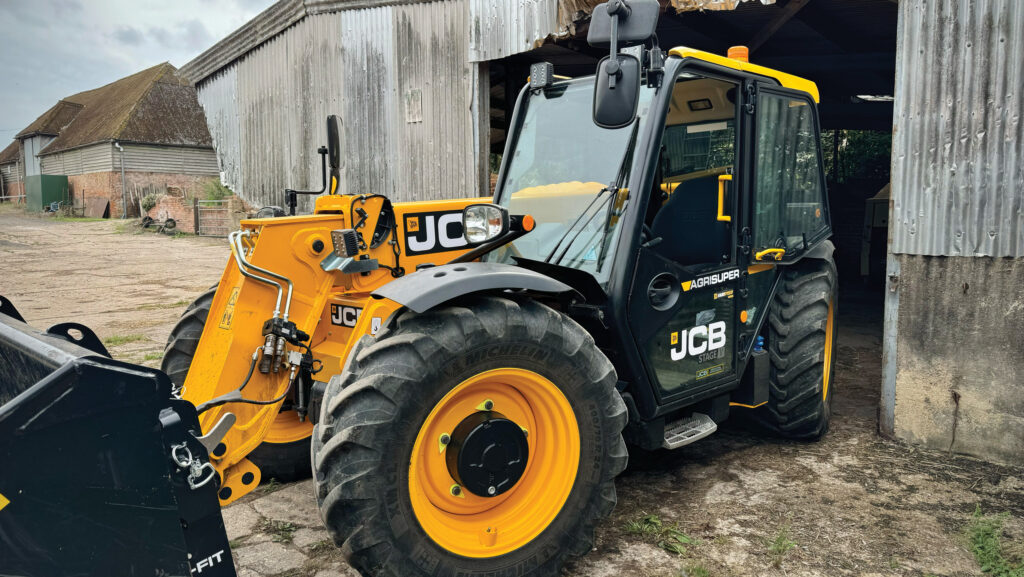
© MAG/Oliver Mark
These tweaks have maintained a respectable 35cm ground clearance, unless you opt for the 20in wheels (which leave just 23cm below the belly).
Like with all these compact models, rightwards visibility is the inevitable concession, and the degree to which it inhibits operators depends largely on their size.
Tallish types stand a reasonable chance of peering over the worst of the obstructions; the vertically challenged have no hope.
This only really applies to views rightwards.
It’s hard to see the far side of the bucket or muck grab – making pillar dodging a high-stakes game of chicken – and the big window turns into a yellow wall with the boom mid-height.
The bonnet interferes too, though JCB claims to have lowered it on this model, and integrating the emissions system does at least get rid of a potentially bulky exhaust stack.
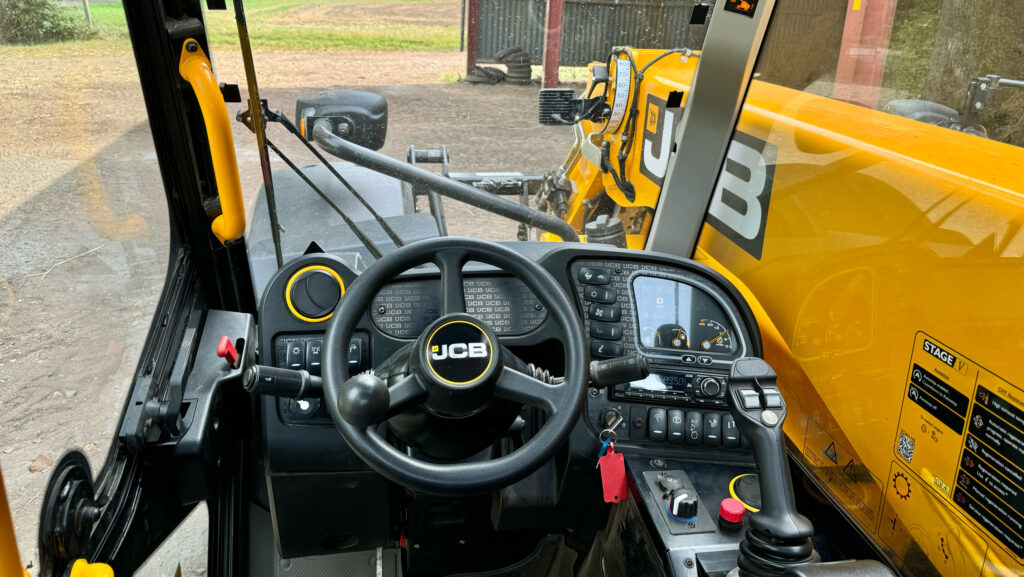
© MAG/Oliver Mark
Basically, the twin wing mirrors are your friend. Treat them with care.
At some point, JCB may well introduce an adapted version of its posher Series 3 cab, which it spent a reported £6m developing for the bigger Loadalls.
The sole item stolen from that design thus far is the swing-out grab handle on the B-pillar, which is a nice, space-saving touch.
But, given operators effectively sit in, rather than on, the machine, the only real benefit of the Series 3 would be headstock visibility through the lifting arc.
As it is, the Series 2 setup includes a flat front pane and a top crossmember separating it from the heavily guarded glass roof, whereas the bigger Loadalls have a curved windscreen that offers unsullied views upwards.
It would be quieter though, by at least 10dBa.
Simple controls
There are no surprises inside, with most buyers likely to be at least vaguely familiar with the old Series 2 frame and switchgear.
It’s now more than 15 years old and certainly nothing fancy, but it’s hard to dislike the simplicity of it all.
Few farmers will be screaming for a 7in screen instead of a traditional dash, dials and rockers, which make it as easy to drive – and, in theory, fix – as anything on the market.
Most of these handlers will be farm dogsbodies, so the bare necessities are all that really count.
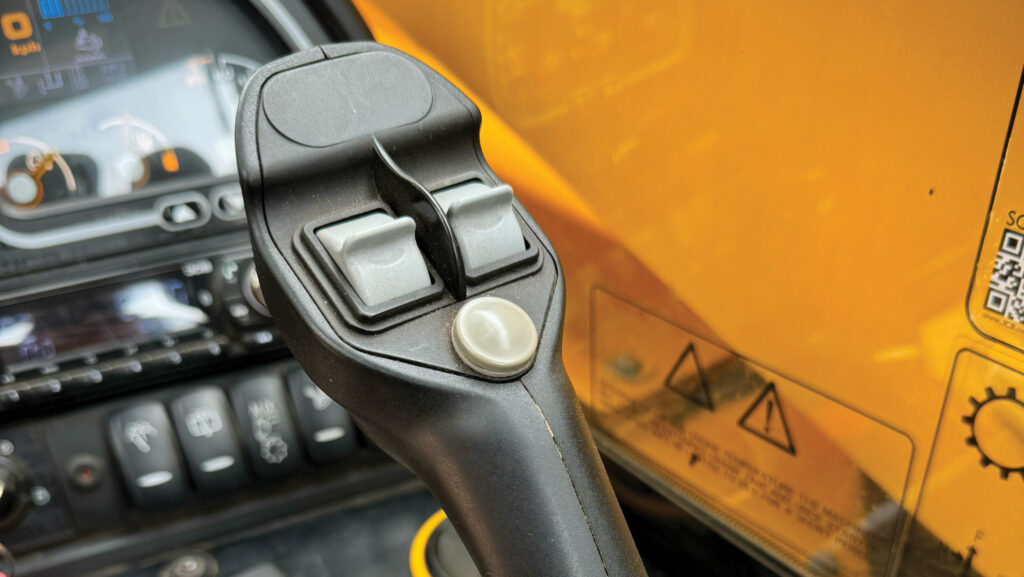
© MAG/Oliver Mark
Granted, it’s small and goes without much in the way of storage space, but the furniture is designed to fit the accommodation – the downsized, go kart-style steering wheel being a case in point.
There is one downside, though.
Lame as it sounds, the wrist rest behind the joystick is too short and awkwardly angled, such that the entire weight of the operator’s arm is centered on an inch of skin.
After a few hours of continuous work, it’ll be red raw.
Plenty of shove
Size and weight belie surprising pushing power, with JCB’s 4.8-litre Dieselmax offering far more poke than the comparatively lame 2.5-litre, 74hp Kohler engine in the other “compact” range tiddler, the 525-60.
At 130hp, it punches well above its weight, to the tune of over 20hp/t. This same block is also fitted in the biggest Loadalls, some of which are good for 173hp.
It’s full of vim, rarely to be found wanting when faced with pyramids of soil and muck – at least until the overload lock-out system sticks its oar in.
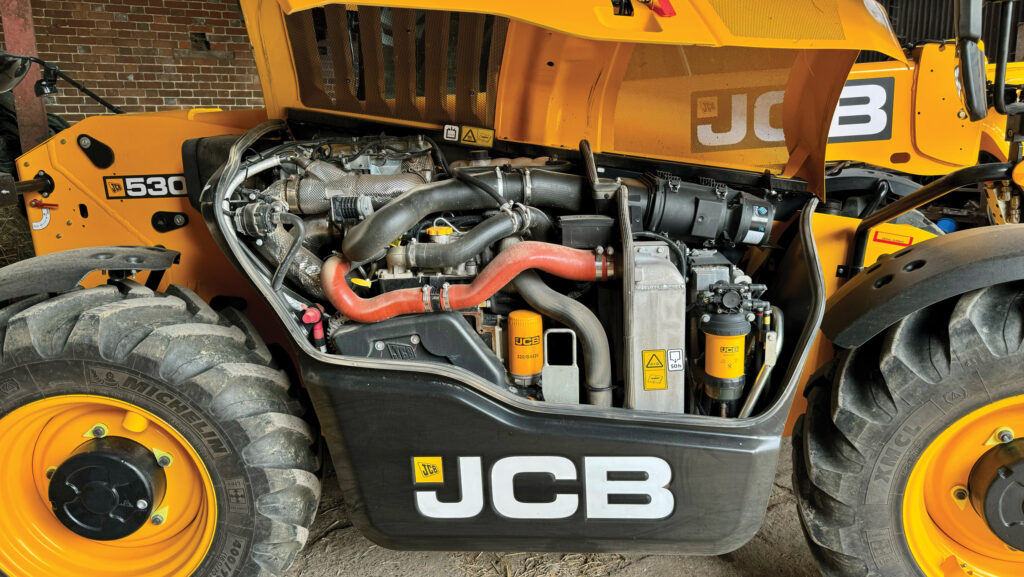
© MAG/Oliver Mark
But we did feel shortchanged as far as diesel capacity goes.
A 66-litre tank might suffice for Granny’s Toyota Aygo, but farming is thirsty work and fill ups come around with depressing frequency. Even its junior, the 525-60, will swallow 75 litres.
With so much power under foot, a powershift transmission option isn’t really missed.
Instead, Bosch Rexroth’s two-range hydrostatic gets the nod, offering a tortoise maximum of 11kph and 40kph in hare.
Handling in the latter is eager and it’s perfect for scurrying around yards, the drawback being that it needs revving hard, which makes it noisy.
There’s scope to curb the top speed using the VariSpeed dial in the corner rear of the cab.
This also allows for the separation of engine and transmission controls when running an auger bucket or brush, leaving a hand throttle to take care of revs and the pedal to preside over forward speed.
And there’s an inching pedal that disconnects drive to the transmission, allowing one to ginger up hydraulic performance by revving the engine without wearing out the brakes.
Useful though it is, the pedal is a permanent trip hazard, so it’s a shame that this function’s place on the joystick spine has been taken by a forward/reverse shuttle rocker.
Speedy hydraulics
The 530-60 comes only in Agri Super guise, meaning buyers get the firm’s “smart hydraulics” package as standard.
The highlight of this, in JCB parlance, is “gravity flow back”. As the name hints, this uses the earth’s force to drop the boom like a stone, thus speeding up cycle times and saving revving the engine.
If nothing else, it might make the diesel last a minute or two longer.
Also included are an automatic bucket shake function, boom suspension, a pressure release button for the auxiliary service positioned just outside the cab, and boom end damping.
All useful stuff that improves accuracy, speed and ease of work.
There’s an adjustable constant pump function for auxiliary flow too, and unnoticeable tweaks to the linkage geometry that have apparently resulted in minor improvements to the dump and crowd angles.
Farmers Weekly verdict
Visibility is the only downside in an otherwise simple, functional and surprisingly powerful machine.
But not being able to see where you’re going is a bit of an issue.
So, unless cab height is a non-negotiable, it might pay to look at the smallest full-sizer – the 532-60.
It’s a bit more money (tempting at £86,322 in Agri spec with four-speed powershift; less so at £103,187 in Agri Super with DualTech VT transmission) but offers a marginally better lift capacity, at 3.2t, and a maximum height of 6.22m.
And it’ll also be easier to sell, not least because it won’t have walloped every stanchion on the farm.
Likes and gripes
Likes
- Powerful for its size
- Low cab roof
- Well balanced
- Simple controls
Gripes
- Uncomfortable wrist rest
- Poor visibility
- Inching pedal is a trip hazard
- Tiny diesel tank
JCB 530-60 Agri Super
- Engine 4.8-litre, four-cylinder JCB Dieselmax
- Max power 130hp@2,200rpm
- Max torque 550Nm@1,500rpm
- Transmission Two-range hydrostatic
- Top speed 40kph
- Operating weight 6,360kg
- Hydraulics 97 litre/min gear pump
- Max lift capacity 3,000kg
- Max lift height 6.09m
- List price £83,242 (24in wheels)

